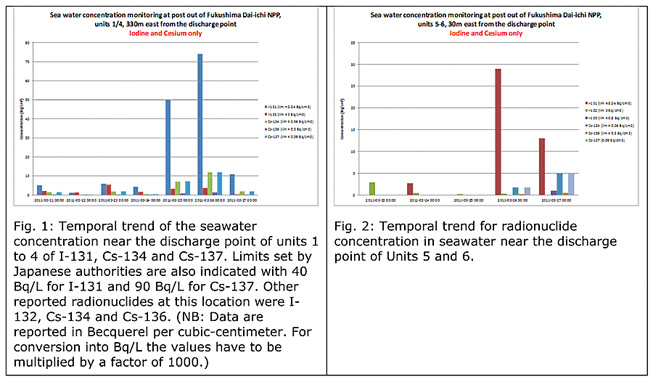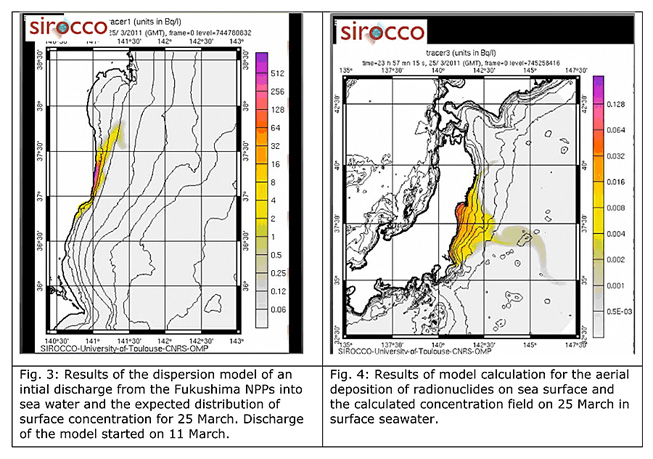→ Chronology of Updates:
2 June | 12-18 May | 4-11 May | 5 May | 3 May | 2 May | 28 April | 27 April | 26 April | 21 April | 20 April | 19 April | 18 April | 15 April | 14 April | 13 April | 12 April | 11 April | 10 April | 9 April | 8 April | 7 April | 6 April | 5 April | 4 April | 3 April | 2 April | 1 April | 31 March | 30 March | 29 March | 28 March | 27 March | 26 March | 25 March | 24 March | 23 March | 22 March | 21 March | 20 March | 19 March | 18 March | 17 March | 16 March | 15 March | 14 March | 13 March | 12 March | 11 March | Full Update
IAEA BRIEFING ON FUKUSHIMA NUCLEAR ACCIDENT (29 March 2011, 16:30 UTC)
Presentations:
→ IAEA Briefing on Fukushima Nuclear Accident
→ Summary of Reactor Status
On Tuesday, 29 March 2011, the IAEA provided the following briefing on the current status of nuclear safety in Japan:
1. Current Situation
The situation at the Fukushima Daiichi plant remains very serious.
Accumulated contaminated water was found in trenches located close to the turbine buildings of Units 1 to 3. Dose rates at the surface of this water were 0.4 millisieverts/hour for Unit 1 and over 1 000 millisieverts/hour for Unit 2 as of 18:30 UTC on 26 March. The Nuclear Safety Commission of Japan suggests that higher activity in the water discovered in the Unit 2 turbine building is supposed to be caused by the water, which has been in contact with molten fuel rods for a time and directly released into the turbine building via some, as yet unidentified path. An investigation is underway as to how the water accumulated in the trenches. Measurements could not be carried out at Unit 3 because of the presence of debris.
Fresh water has been continuously injected into the Reactor Pressure Vessels (RPVs) of Units 1, 2 and 3. From today at Unit 1, the pumping of fresh water through the feed-water line will no longer be performed by fire trucks but by electrical pumps with a diesel generator. The switch to the use of such pumps has already been made in Units 2 and 3. At Unit 3, the fresh water is being injected through the fire extinguisher line.
At Unit 1, there has been an increase in temperature at the feed-water nozzle of the RPV from 273.8 °C to 299 °C. The temperature at the bottom of the RPV remained stable at 135 °C. Temperatures at Unit 2 appear relatively stable at the same measurement points. At Unit 3, the temperature at the feed-water nozzle of the RPV is about 61.5 °C and 120.9 °C at the bottom of the RPV. The validity of the RPV temperature measurement at the feed water nozzle is still under investigation.
With the increase in temperature at Unit 1, there has been a corresponding increase in Drywell pressure. In the Drywell of Unit 2, the indicated pressure dropped slightly and is just above atmospheric.
It is planned to begin pumping fresh water into the spent fuel pool of Unit 4 today, on 29 March.
Units 5 and 6 remain in cold shutdown.
2. Radiation Monitoring
On 28 March, deposition of iodine-131 was detected in 12 prefectures, and deposition of cesium-137 in 9 prefectures. The highest values were observed in the prefecture of Fukushima with 23 000 becquerel per square metre for iodine-131 and 790 becquerel per square metre for caesium-137. In the other prefectures where deposition of iodine-131 was reported, the range was from 1.8 to 280 becquerel per square metre. For caesium-137, the range was from 5.5 to 52 becquerel per square metre. In the Shinjyuku district of Tokyo, the daily deposition of both iodine-131 and cesium-137 was below 50 becquerel per square metre. No significant changes were reported in the 45 prefectures in gamma dose rates compared to yesterday.
As of 28 March information on radioactivity in drinking water collected mainly from the Japanese Ministry of Health, Labour and Welfare indicates that recommendations for restrictions based on I-131 concentration remain in place only in four locations in the prefecture of Fukushima. To date, no recommendations for restrictions have been made based on Cs-137. The Japanese limits for the ingestion of drinking water by infants is 100 becquerel per litre.
Five soil samples, collected at distances between 500 and 1 000 metres from the exhaust stack of Unit 1 and 2 of the Fukushima Nuclear Power Plant on 21 and 22 March, were analysed for plutonium-238 and for the sum of plutonium-239 and plutonium-240. (Due to analytical reasons, the isotopes plutonium-239 and plutonium-240 cannot be measured separately). Plutonium-238 was detected in 2 of the 5 samples, while plutonium-239/240 was detected in all samples as expected.
Concentrations reported for both, plutonium-238 and plutonium-239/240 are similar to those deposited in Japan as a result of the testing of nuclear weapons. The ratio of the concentrations of plutonium-238 and plutonium-239/240 in two of the samples indicate that very small amounts of plutonium might have been released during the Fukushima accident, but this requires to be further clarified.
As far as food contamination is concerned, 63 samples taken from 24 - 29 March, and reported on from 27 - 29 March, for various vegetables, fruit (strawberries), mushrooms, eggs, seafood and pasteurized milk in eight prefectures (Chiba, Fukushima, Gunma, Ibaraki, Miyagi, Niigata, Tochigi and Yamagata), stated that results for iodine-131, caesium-134 and caesium-137 were either not detected or were below the regulation values set by the Japanese authorities.
The Joint FAO/IAEA Food Safety Assessment Team met with local government authorities in Ibaraki prefecture on Monday and provided advice related to contamination of food and the environment, including the mechanisms and persistence of such contamination, examples of remediation strategies, international standards and sampling plan designs and radionuclide transfer from soil to plants, particularly as related to rice production in the area.
Local government authorities briefed the FAO/IAEA Team on the extent of contamination in Ibaraki, the principle agricultural products affected, the main production areas and production methods (greenhouse, open-air) and levels of contamination found.
The FAO/IAEA team is also meeting with the local authorities in Tochigi prefecture today, and will meet with local government officials in Gunma tomorrow.
Sea Water Samples
No new results from the marine monitoring stations 30 km off-shore were reported for 27 or 28 March. However, new analyses in seawater 330 m east to the discharges point of NPP Units 1 - 4 were made available for 27 March. These concentrations show a significant decrease from 74 000 Becquerel per litre of iodine-131, 12 000 Becquerel per litre of cesium-137, and 12 000 Becquerel per litre of cesium-134 on 26 March to 11 000 Becquerel per litre of iodine-131 and 1 900 Becquerel per litre of cesium-137 on 27 March.
Sea water samples were also collected daily at a location 30 m from the common discharge point for Units 5 - 6. These results also show an increase in the radionuclide concentrations on 26 March. The sea water samples collected on March 27 show as well a decrease of the radionuclide concentration.

It can be expected that the data will be quite variable in the near future depending on the discharge levels. In general, dilutions by ocean currents and into deeper waters as well decay of short lived radionuclides e.g. I-131 or I-132 will soon lead to lower values.
Marine Organisms
First analyses were reported in fish carried out by the National Research Institute of Fishery Research. 5 samples of fish were collected from the port of Choshi (Chiba prefecture) and 4 of 5 samples showed Cs-137 concentrations below limit of detection. In one sample Cs-137 was found with 3 Bq/kg (fresh weight) and it was reported that it was slightly above the limit of detection. This concentration is far below any concern for fish consumption.
It is still too early to draw conclusions for expected concentrations on marine food, because the situation may change rapidly, however, it is expected that the detected initial concentrations of seawater will soon drop to lower values by dilution and the levels in marine food will most likely not reach levels above given limits for consumption, (presuming that discharges of contaminated seawater from the reactor will not continue). It is not expected that fish or other marine food will be collected in a close area to the NPP Fukushima at the present situation. Some marine algae are known to accumulate in particular I-131 and Tc-99m. However, these values will soon be of no concern due to the short half-lives of the radionuclides mentioned.
Modelling Marine Dispersion
The Group SIROCCO of the Observatoire Midi-Pyrenées of the University of Toulouse, CNRS, is continuing to carry out model calculations. The model is based on an ocean circulation and current weather conditions and they results showed an initial north-eastern transport of liquid releases from the damaged reactors and the contaminated water would reach the northern monitored stations between 1 and 2 weeks later.
A model with tracer release directly in the sea show an along shore propagation in the southern direction and a northeast propagation moving away from the coast.

With tracer release from atmospheric deposition, the propagation stretch offshore entering the Kuro-Shivo current in few days.
The first results are shown in Fig. 3 and 4. The data are converted into Bq/L by assuming arbitrary discharge or aerial release activities, respectively. The results should just be taken as indication of the dilution capacity and transport route of sea water.

